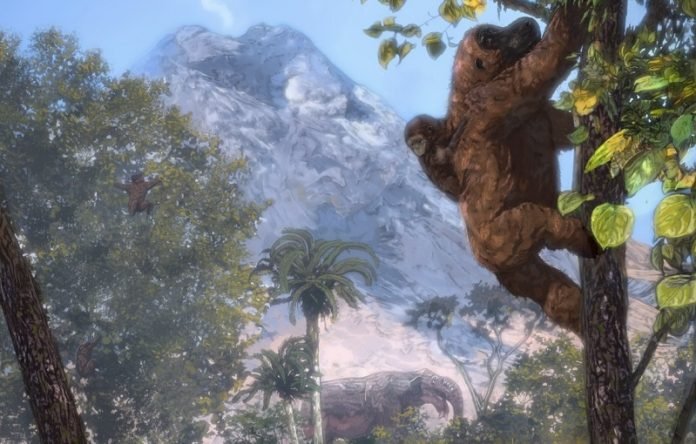
A pair of studies published April 14 in the journal Science paint a new picture about apes, ancient Africa and the origins of humans.
Many scientists had once hypothesized that the first apes to evolve in Africa more than 20 million years ago ate primarily fruit and lived within the thick, closed canopy of a nearly continent-wide forest ecosystem.
Instead, the new research indicates that early apes ate a leafy diet in a more arid ecosystem of varyingly open woodlands with abundant grasses.
The findings by an international team of paleontologists, primate experts and plant scientists — including paleobotanists at the University of Washington — push the origin of tropical ecosystems dominated by C4 grasses back by more than 10 million years.
In doing so, they link the emergence of C4 grasses — named for the type of photosynthesis they employ to make food from the sun’s energy — to the emergence of the forerunners to all apes living today.
That includes the most abundant ape in history: humans.
Previously, many researchers argued that during the early Miocene, between about 15 and 20 million years ago, equatorial Africa was covered by a semi-continuous forest. Under that hypothesis, more open habitats with C4 grasses didn’t proliferate until about 8 to 10 million years ago.
Yet one study showed some evidence of C4 grasses in East Africa around 15 million years ago. The research team wanted to understand if that study was an anomaly or a clue to the true diversity of ecosystems at that time.
“The history of grassland ecosystems in Africa prior to 10 million years had remained a mystery, in part because there were so few plant fossils,” said co-author Caroline Strömberg, the Estella B. Leopold Professor of Biology at the UW.
The international collaboration — funded largely by the National Science Foundation — drew together multiple different lines of evidence to try to reconstruct the species that dominated East Africa in the early Miocene. Researchers incorporated analyses of fossil soils, animal fossils, stable isotopes and phytoliths, which are plant silica microfossils.
Strömberg, who is an expert in phytoliths, worked with co-authors Alice Novello, a former UW postdoctoral scientist who is currently working at Aix-Marseille University in France, and Rahab Kinyanjui of the National Museums of Kenya and the Max Planck Institute of Geoanthropology in Germany to reconstruct what types of plants were present at several sites in East Africa during the early Miocene.
“Phytoliths are particularly informative for revealing the history of grassland ecosystems. They can tell us not just that there were grasses, but which grasses were there and how abundant they were on the landscape,” said Strömberg, who is also curator of paleobotany at the UW’s Burke Museum of Natural History and Culture.
Their data, combined with other lines of evidence, essentially disproved the theory that equatorial Africa in the early Miocene was heavily forested. The findings have important implications for understanding the features and adaptations of early apes.
“Multiple lines of evidence show that C4 grasses and open habitats were important parts of the early Miocene landscape and that early apes lived in a wide variety of habitats, ranging from closed canopy forests to open habitats like scrublands and wooded grasslands with C4 grasses,” said co-author Daniel Peppe, an associate professor of geosciences at Baylor University.
“It really changes our understanding of what ecosystems looked like when the modern African plant and animal community was evolving.”
“What we found was thrilling, and very different from what was the accepted story,” said Strömberg. “We used to think tropical, C4 dominated grasslands only appeared in the last 8 million years or so, depending on the continent.
Instead, both phytolith data and isotopic data showed that C4 dominated grassy environments appeared over 10 million years earlier, in the early Miocene in eastern Africa.”
In addition to its findings about C4 grassy habitats, the team is also reporting discoveries about a 21-million-year-old fossil ape, Morotopithecus. Anthropologists long thought that our ape ancestors evolved an upright torso in order to pick fruit in forests.
With an upright posture, an ape can more easily grab onto different branches with its hands and feet. Morotopithecus definitely had an upright stature. Paleontologists on the team performed careful analyses of the shape of its molars, as well as the chemical composition of its dental enamel, to determine its diet.
“The expectation was: We have this ape with an upright back. It must be living in forests and it must be eating fruit,” said co-author Laura MacLatchy, a professor of anthropology at the University of Michigan.
“But as more and more bits of information became available, the first surprising thing we found was that the ape was eating leaves. The second surprise was that it was living in woodlands.”
Together, the evidence showed that Morotopithecus lived in a seasonal woodland with a broken canopy composed of trees and shrubs and open, grassy areas.
In addition, the team’s plant and climate reconstruction efforts determined that, for at least part of the year, Morotopithecus had to rely on leaves and other plant material — instead of fruit — for food.
The fact that abundant C4 grass and woodland ecosystems arose much earlier than once thought also upends another view of human origins: That our bipedalism evolved as a response to the emergence of grassland environments in Africa between 10 and 7 million years ago.
“Now that we’ve shown that such environments were present at least 10 million years before bipedalism evolved, we need to really rethink human origins, too,” said MacLatchy.



